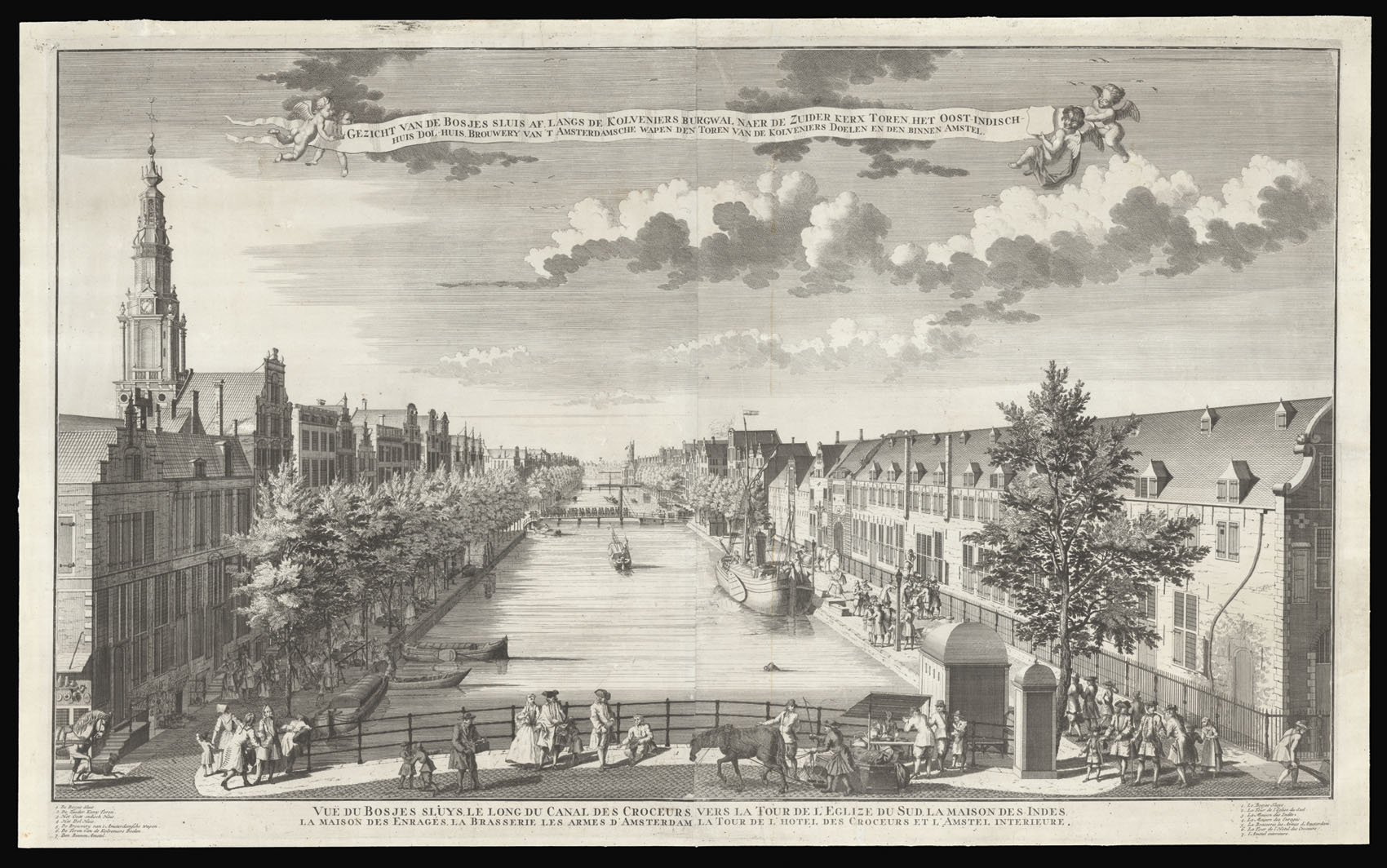

A fine eighteenth century view of the Kolveniersburgwal
Gezicht van de Bosjes Sluis af langs de Kolveniers Burgwal naer de Zuider Kerk toren het Oost-Indisch Huis Dol Huis, Brouwery van t' Amsterdamsche wapen den yoren van de Kolveniers doelen en den binnen Amstel. Vüe du bosjes sluys le long du canal des croceurs vers la tour de l'eglize du sud la maison des indies, la maison des enrages, la brasserie les armes d'amsterdam, la tour de l'hotel des croceurs et l'amstel interieure.
- 作者: [STOOPENDAAL, Bastiaen]
- 出版地: Amsterdam,
- 发布日期: [c1700].
- 物理描述: Engraving with etching on two sheets joined.
- 方面: 554 by 900mm. (21.75 by 35.5 inches).
- 库存参考: 14410
笔记
View of the Kolveniersburgwal, taken from the Bushuissluis looking towards the Amstel river.
A key in Dutch and French lists seven places of interest these include among others the 'Bosjes Sluis', the bridge spanning the canal; the impressive Zuiderkerk tower; the Oost-Indisch Huis, or East India Company House; and the tower of the Koveniersdoelen, from whence the canal gained its name. The Kloveniersdoelen ("musketeers' shooting range") was a complex of buildings in Amsterdam which served as headquarters and shooting range for the local schutterij (civic guard). The companies of kloveniers were armed with an early type of musket known as an arquebus, known in Dutch klover, hence the name kloveniers.
The print depicts a bustling city with gentlemen and women rubbbing shoulders with street vendors and beggars. To the right of the view a large barge is shown off-loading its wears next to East India House. To the left women are shown unloading crockery for sale in the local market. Further down the canal more boats ply their trade and in the distance the one can just pick out the Amstel river.
A later state of the print with a new impressive building constructed on the left hand side of the print, partially blocking out the Zuiderkerk.
Bastiaen Stoopendaal (1636-1707) etcher, engraver, painter, and draftsman lived and worked in Amsterdam, he was father of the artist Daniel Stoopendaal, and his most famous pupil was Jan Kip.
A key in Dutch and French lists seven places of interest these include among others the 'Bosjes Sluis', the bridge spanning the canal; the impressive Zuiderkerk tower; the Oost-Indisch Huis, or East India Company House; and the tower of the Koveniersdoelen, from whence the canal gained its name. The Kloveniersdoelen ("musketeers' shooting range") was a complex of buildings in Amsterdam which served as headquarters and shooting range for the local schutterij (civic guard). The companies of kloveniers were armed with an early type of musket known as an arquebus, known in Dutch klover, hence the name kloveniers.
The print depicts a bustling city with gentlemen and women rubbbing shoulders with street vendors and beggars. To the right of the view a large barge is shown off-loading its wears next to East India House. To the left women are shown unloading crockery for sale in the local market. Further down the canal more boats ply their trade and in the distance the one can just pick out the Amstel river.
A later state of the print with a new impressive building constructed on the left hand side of the print, partially blocking out the Zuiderkerk.
Bastiaen Stoopendaal (1636-1707) etcher, engraver, painter, and draftsman lived and worked in Amsterdam, he was father of the artist Daniel Stoopendaal, and his most famous pupil was Jan Kip.
参考书目
- R.W.P. de Vries, auction, 1925: 281
图片库
/
 地图
地图  地图集
地图集  珍本
珍本  版画
版画  天文仪器
天文仪器 










